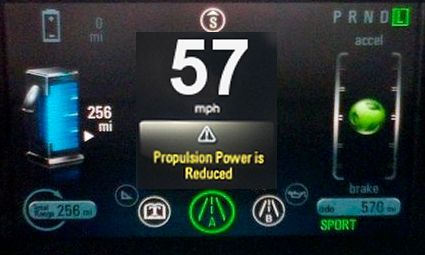I told the story of Derek and me driving to Northern Arizona yesterday to see the eclipse in some detail in my previous post, and I mentioned that I took my Volt. Here is some info on what it was like driving an “extended range electric vehicle” on a mountainous highway.
As I’ve posted before, the Volt is an electric car that carries its own generator so when the battery is fully discharged you can continue to go. The generator is sized so that on average it provides enough power to drive the car as fast as you need — it’s 1.4 liters. That’s a lot more power than is needed to keep the car going on a level highway. When you need to accelerate or go up a hill, the car can briefly draw supplementary power from the battery to give a boost, and then when you are coasting the little engine can replace the energy it withdrew and prepare for the next boost.
This system works fine under normal circumstances, but when you are driving over 100 miles mostly up hill, the generator can’t keep up. The Volt is a fairly heavy car and 1.4 liters isn’t enough to drive it 80 miles an hour up a steep mountain highway.
So what Chevy did to solve this problem is add a mode called “Mountain Mode”. Here’s how it works:
As I was leaving Phoenix yesterday, somewhere south of Anthem, I shifted the car into Mountain Mode in preparation for the climb ahead. In this mode the engine produces more energy than it needs to move the car and partially recharges the battery. As you hit the hills and the engine can no longer keep up, it starts to draw some of that excess energy from the battery to provide supplementary power. As you crest each hill, or the road becomes less steep, the engine again puts energy back into the battery.
In this way I was able to drive 80 mph all the way to Flagstaff (where legal, of course), passing the “slower” cars with ease. I never felt under powered, and was able to accelerate up the hills. It’s no V8, of course, and there wasn’t strong acceleration at 80 mph going up a hill, but it was fine.
When I arrived in Flagstaff, we stopped for a snack and when we got back in the car I switched out of Mountain Mode and was surprised to discover that I had almost a half-full battery. I was able to drive beyond Flagstaff on only electricity before the engine had to kick in again.
On the way home I thought the road was downhill almost all the way, so I didn’t bother with Mountain Mode. This worked fine until we passed Camp Verde and started up that long climb towards the Prescott turn-off. About half-way up the hill the Volt flashed me a warning “Propulsion power is reduced!”, and we began to slow down — the engine couldn’t keep up, and the battery didn’t have any extra power to donate. I was doing 70 up the hill until then, but I watched my speed slowly drift down — 69… 65… 63… until we finally bottomed out at about 57, where the engine could finally just keep up. Once we crested the hill, we were able to once again accelerate to full speed and had no further problems.

I have completely blown my lifetime MPG with this trip, but that’s OK. A car is to be driven and it was a fun experiment to see how the Volt performs under challenging circumstances. With the one difference that you have to manage Mountain Mode, it ran just like any other car up the hill with power to spare.
I averaged 38 MPG for the trip — about 26 MPG going up and over 50 MPG coming down. Not bad. And I finally had to figure out how to open and fill the gas tank for the first time yesterday. After about 2500 miles, I have now burned about 16 gallons of gas.
